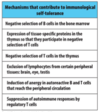EXAM 4 Adaptive Immune Disease Flashcards
autoimmune diseases are loss of ___, leading to ___ reactions
- tolerance
- hypersensitivity
describe autoimmune diseases
- adaptive immune targeting of self
- humoral or cell mediated
- often chronic and life long
- loss of self-tolerance
- hypersensitivity reactions - type II, III, and IV
what are mechanisms that contribute to immunological self-tolerance?

autoimmune disorders are caused by ___, ___, or ___
genetics, the environment, or both
there are more than ___ autoimmune diseases
80
___% of the US population is affected by autoimmune disorders
3%
autoimmune diseases are among the 10 leading causes of death among what population?
women under 65
genetic predisposition to autoimmune diseases is important. only ___% of predisposed individuals get autoimmune disease
20%
are there infectious and non-infectious causes of autoimmune diseases?
yes, both
___ subtype influences autoimmune disease development
HLA
how do HLA subtypes influence autoimmune disease development?
- HLA genes associated with susceptibility in 50% of autoimmune diseases
- class II alleles most frequently implicated
- CD4 T cells closely tied to autoimmune disease development
- susceptibility does not always lead to disease
type II hypersensitivity is mediated by what immunolobulins?
IgG or IgM
type II hypersensitivity reactions target ___
cell surface proteins
in type II hypersensitivity, are antibodies agonistic or antagonist?
they can be both
rheumatic fever is caused by ___
molecular mimicry
describe the pathogenesis of rheumatic fever
- staph pyogenes throat infection
- s. pyogenes cell wall shares human epitopes
- transient due to lack of T cell help
- demonstrates T cell necessity for prolonged autoimmunity

describe graves disease
- antibody binding causes metabolic dysfunction
- antibodies function as a TSH agonist
- CD4 Th2 response
- excessive thyroid hormone release
- antibodies do not cause overt tissue damage
- hyperthyroid condition - weight loss, heat intolerance, anxiety and irritability, exophthalmos
- thyroid ablatement

describe how antibody-mediated autoimmune disorders can be temporarily transferred to newborns

what is hashimotos disease?
- destruction of normal thyroid tissue
- CD4 Th1 response
- hypothyroidism
- ectopic lymphoid tissue formed in the thyroid
- enlarged thyroid present swallowing difficulty
___ is a form of hypothyroidism, and ___ is a form of hyperthyroidism
- hashimotos disease
- graves disease
___ is a disease that causes progressive destruction of the exocrine glands
sjogrens syndrome
describe how sjogrens syndrome is one of the most common autoimmune disorders
- 0.5% to 5% prevalence
- 9 times more prevalent in women
- utah has one of the largest known patient populations
sjogrens syndrome is a type ___ hypersensitivity
II
what are some clinical manifestations of sjorgrens syndrome?
- dry eyes, dry mouth, and arthritis
- dramatically reduced salivary flow, tongue scaling, diffuse submandibular swelling, prominent caries, oral candidiasis
what are the initiating factors of sjogrens disease?
unknown
type III autoimmune diseases are ___ mediated, form large ___ complexes, cause ___ and ___, and can lead to ___ diseases
- IgG
- immune
- rashes, kidney dysfunction
- rheumatic
describe systemic lupus erythematosus (SLE)
- widespread self-antigen targeting and complex deposition
- deposits in the blood vessels, kidneys, and joints
- epitope spreading leads to intracellular antigen targeting
what is the cause of SLE?
unknown cause, potential environmental trigger
what is the external and oral presentation of SLE during a flare-up?
- external - rash on the face that looks like a wolf
- oral - mouth ulcers and plaques
- not necessarily painful at onset
___ causes intermolecular epitope spreading
SLE
- macromolecular complex presentation
- slowly expanding adaptive response
- loss of tolerance

type IV hypersensitivity autoimmune diseases are ___ mediated, involve ___ hypersensitivity, and ___ is tied to increased autoimmune disease incidence
- CD4 and CD8
- contact
- thymic involution
___ is an example of a type IV hypersensitivity autoimmune disease
celiac disease

describe autoimmunity in type I diabetes
- HLA-DR3/4 linkage
- CD4 and CD8 T cell resposne kills beta cells
- viral cross-reactivity model
- molecular mimicry
- stress
- epitope spreading - intraepitope and interepitope
what are the oral manifestations of type I diabetes?
- reduced salivary flow
- altered saliva composition
- impaired wound healing
- sweet breath


